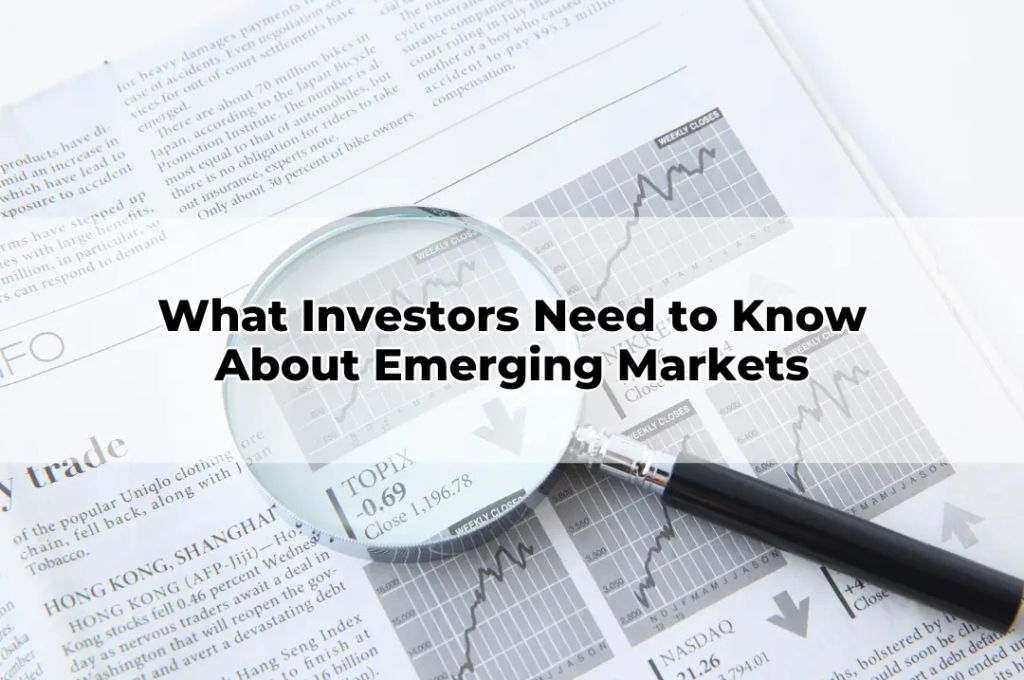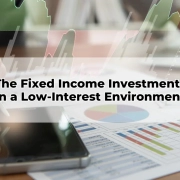What Investors Need to Know About Emerging Markets
Table of Contents
ToggleEmerging markets refer to economies in transition from developing to developed status. These countries often experience rapid industrialisation, population growth, and economic reform, making them fertile ground for capital appreciation. Investors may encounter opportunities in nations across Asia, Latin America, Eastern Europe, and parts of Africa. Unlike established markets, emerging economies may exhibit volatility, but they also offer potential for outsized returns.
The allure lies in demographics, technology adoption, and urbanisation trends that drive domestic consumption and productivity. However, investing in these markets requires a nuanced strategy. Political instability, regulatory uncertainties, and currency risks must be factored in. Yet, for those with a long-term view and risk tolerance, emerging markets can act as a growth engine within a diversified investment portfolio.
For clients seeking a globalised approach to wealth accumulation, understanding the nuances of emerging markets is essential. As a Toowoomba Financial Adviser, I emphasise the importance of strategic positioning in international arenas to future-proof retirement outcomes and overall financial resilience.
Why Investors Should Pay Attention to Emerging Economies
The global financial landscape is shifting. Developed economies face demographic stagnation and subdued growth. Conversely, emerging markets are exhibiting upward economic momentum, spurred by expanding middle classes, infrastructure development, and increasing foreign direct investment.
For investors, these economies offer diversification benefits away from a domestically concentrated portfolio dominated by financials and mining. The Australian market, while mature, is inherently limited by its size. Exposure to emerging markets introduces new sectors, like technology in India or consumer goods in Southeast Asia, which are not prominent in Australia.
Moreover, as the demand for commodities continues in industrialising nations, Australian exporters also stand to benefit. Understanding these interdependencies provides dual exposure-both through direct investment and through the tailwinds supporting domestic business.
As an Online Financial Adviser and SMSF strategist, I help clients harness emerging market exposure prudently, ensuring it complements broader financial planning strategies for long-term wealth creation.
Key Characteristics of Emerging Markets
Emerging markets are typified by several defining features. Firstly, they exhibit rapid GDP growth compared to developed nations. This is largely driven by a youthful, growing population, expanding workforce, and urban migration. Such conditions lay the groundwork for increased productivity and consumer spending.
Secondly, these markets often possess underdeveloped but improving financial systems. This transition stage can result in increased volatility, but it also signals significant reform potential. Governments in emerging economies frequently invest in education, healthcare, and infrastructure-elements that catalyse sustainable development.
Lastly, these economies tend to be commodity-intensive and export-driven. Their dependence on external demand can introduce vulnerability during global downturns. However, structural shifts toward self-sustaining consumption are gradually emerging, particularly in Asia.
Understanding these characteristics allows a more measured approach to risk and return. Within the context of Financial Planning Toowoomba, strategic emerging market exposure is tailored to align with the investor’s risk profile, income needs, and retirement horizon.
Risk Factors Unique to Emerging Market Investments
Investing in emerging markets is not without complexity. Political risk is prevalent, as democratic institutions and legal frameworks may be less robust. Policy shifts, corruption, or regulatory interference can disrupt market confidence and performance.
Currency volatility is another key consideration. Many emerging nations operate with unstable currencies prone to devaluation. This can amplify losses when converting returns back to Australian dollars. Inflation, too, can be high and unpredictable, impacting the real value of investment gains.
Additionally, corporate governance and transparency may fall short of developed market standards. Investors may face difficulty obtaining reliable financial data, or companies may operate under less stringent disclosure requirements.
While these risks are real, they can be mitigated. Diversification across multiple countries and sectors, combined with institutional-grade research and financial advice, is crucial. Through personalised retirement financial advice, investors are empowered to navigate these risks judiciously.
How Emerging Markets Fit into a Diversified Portfolio
A well-balanced investment strategy includes exposure to both developed and emerging markets. Emerging markets provide a counterbalance to the slow-growth environment of developed economies. Their higher growth trajectory can uplift overall portfolio performance.
Moreover, emerging markets often behave differently in response to global macroeconomic changes, providing non-correlated assets that reduce overall portfolio volatility. This means that while they may be riskier in isolation, within a diversified structure they can enhance risk-adjusted returns.
From a retirement planning standpoint, incorporating emerging markets can be a prudent decision. It ensures that retirees are not solely reliant on domestic equity or fixed income returns, which may be insufficient to meet long-term income needs.
As a Toowoomba Financial Adviser, my role is to evaluate the appropriate level of emerging market exposure based on the client’s goals, life stage, and investment horizon.
Common Vehicles for Accessing Emerging Market Investments
There are several avenues through which Australian investors can access emerging markets. Exchange-traded funds (ETFs) are one of the most efficient tools. These funds offer instant diversification across countries and sectors, and they can be traded on the ASX.
Managed funds are another option, often actively managed by global fund managers with on-the-ground expertise. These may come at higher fees but can deliver superior returns through localised knowledge and active allocation.
Direct equity investment is possible but generally not recommended for retail investors due to the complexity and risk of investing in foreign-listed companies. Sovereign or corporate bonds from emerging nations offer fixed-income exposure but come with credit risk.
As an Online Financial Adviser, I guide clients through the selection of appropriate vehicles, ensuring cost-efficiency, transparency, and alignment with the broader financial plan.
The Role of Emerging Markets in SMSFs
Self-Managed Superannuation Funds (SMSFs) provide greater control over asset allocation. For trustees seeking international diversification, emerging markets represent a valuable inclusion. They offer growth opportunities beyond the local market, which is essential for building a retirement nest egg that can withstand economic shifts.
Through ETFs or managed funds held within an SMSF, trustees can achieve cost-effective, diversified exposure. However, the inclusion of emerging markets must be justified within the investment strategy and should reflect the SMSF’s risk tolerance and objectives.
As an SMSF specialist, I assist trustees in assessing whether emerging market exposure aligns with compliance obligations and long-term financial outcomes. Strategic integration into the fund’s investment strategy ensures not only diversification but also future-facing positioning.
Geopolitical Influences on Emerging Market Performance
Geopolitical factors often exert significant influence on emerging markets. Trade tensions, border disputes, sanctions, or changes in global alliances can ripple through these economies. For example, a U.S. interest rate hike can lead to capital flight from emerging nations, affecting liquidity and valuations.
It’s essential for investors to be aware of such macroeconomic dynamics. Political transitions in large economies such as Brazil, India, or Turkey can affect investor sentiment globally. Similarly, global commodity prices-often linked to political and climate-related developments-can disproportionately affect emerging economies reliant on exports.
As part of my approach to Financial Planning Toowoomba clients, I integrate macroeconomic analysis into the portfolio construction process. This ensures that the emerging market allocation is not only appropriate but also resilient in the face of global uncertainties.
Currency and Inflation Risks in Emerging Markets
Currency fluctuations can significantly impact returns from emerging markets. Unlike developed economies, many emerging nations have volatile currencies susceptible to political turmoil, inflation, and trade imbalances. A falling local currency erodes gains when converting investments back to Australian dollars.
Inflation risk is another challenge. High inflation can reduce purchasing power and distort asset values. In many emerging markets, inflation is less predictable and subject to political and external shocks, such as oil price volatility or agricultural disruption.
To manage these risks, hedged investment vehicles and careful country selection are essential. I work with clients to identify the right blend of unhedged and hedged instruments, tailoring the investment plan to mitigate inflationary erosion while capitalising on currency movements where advantageous.
Long-Term Investment Outlook for Emerging Markets
Despite short-term volatility, the long-term outlook for emerging markets remains positive. Structural factors such as population growth, increasing consumption, and digital transformation underpin sustained economic expansion. The rise of middle-class consumers in countries like India, Vietnam, and Indonesia creates significant demand for goods, services, and infrastructure.
Emerging markets are also becoming more integrated into global supply chains and financial systems. As their institutions mature and governance improves, investor confidence continues to rise. Over time, these changes may reduce risk premiums and improve capital flows.
For long-term investors, emerging markets offer not just diversification but the potential for wealth creation that outpaces developed economies. By incorporating a forward-looking investment framework, I help clients tap into these megatrends as part of their retirement financial advice strategy.
Strategies for Managing Volatility in Emerging Markets
Volatility is an inherent feature of emerging market investing. However, it can be managed effectively through a combination of asset allocation, diversification, and disciplined rebalancing. Investing across multiple countries and sectors helps dilute the impact of any single market downturn.
Time horizon is crucial. Investors should adopt a long-term perspective, allowing sufficient time for volatility to average out. Dollar-cost averaging into emerging market funds can also reduce the risk of entering the market at a peak.
From a financial planning standpoint, volatility is addressed through comprehensive risk profiling and scenario modelling. My approach ensures that each client’s emerging market exposure is not only appropriate but also structured to support broader financial goals and retirement income planning.
Partnering with a Professional Adviser for Emerging Market Investment
Navigating emerging markets requires more than surface-level knowledge. Investors need access to reliable research, institutional-grade fund selection, and an understanding of global economic cycles. Working with a qualified financial adviser ensures that emerging market investments are implemented within a strategic framework.
As a Toowoomba Financial Adviser and SMSF specialist, I provide a disciplined, data-driven approach to international investing. Whether through ETFs, managed funds, or retirement portfolios, each decision is grounded in rigorous analysis and aligned to individual objectives.
For those seeking to diversify beyond Australian borders and position their wealth for future growth, emerging markets represent a compelling avenue. With the right guidance, this opportunity can be harnessed to create enduring financial security and retirement confidence.









